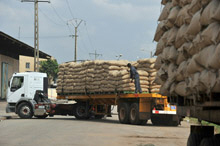
Typical street scene in Santa Ana, El Salvador. (Photo: iStock)
IMF Survey: Resilient Côte d'Ivoire Gets $615 Million IMF Loan to Back Recovery
November 4, 2011
- Main economic strategy goal is to rebuild economy after years of internal crisis
- Since mid-2011 business enterprises have begun to come back to life
- Critical to normalize banking to provide enough credit for economic recovery
The IMF Executive Board approved a $615 million loan to Côte d’Ivoire to back the West African country’s rebound from a decade of civil unrest.

Cocoa shipment arrives at port of Abidjan, Côte d’Ivoire, where conflict has left infrastructure needing rehabilitation, expansion (photo: Issouf Sanogo/AFP)
WEST AFRICA
The loan supports a medium-term policy program that features a range of structural reforms to accelerate the country’s economic recovery and lay the foundations for poverty reduction through sustained growth in economic activity and employment.
The IMF Board approved November 4 a new three-year arrangement under the Extended Credit Facility. The loan is intended to underpin the main goal of the government’s economic strategy: to rebuild the economy after years of internal crisis, weak investment, low growth, and low employment.
To foster a dynamic private sector able to create jobs and reduce poverty, the government is embarking on reforms to make the economy more efficient and aims to increase public investment, partnering on infrastructure projects with the private sector where possible.
Infrastructure has degraded badly following a decade of political crisis, leaving large rehabilitation and expansion needs. All of this requires more investment than Côte d’Ivoire has had in years, both public and, especially, private. But the initial recovery has been surprisingly strong, and the country is off to a good start—with real growth projected at 8½ percent for 2012.
Road to recovery
A five month-long crisis that followed former president Laurent Gbagbo’s refusal to leave office after the presidential elections in November 2010 ended with his arrest in mid-April. The government subsequently requested support under the IMF’s Rapid Credit Facility, and also sought emergency technical assistance in tax and customs administration to help restart the economy.
As soon as the national security situation began to improve, the IMF’s Resident Representative and local staff returned to Abidjan after four months of evacuation. They were followed by a staff team from Washington that reviewed the economic policy options. By end-May, the team had helped the authorities put together a budget—full of uncertainties, but a starting point—and an economic recovery program for 2011 that could be supported under the Rapid Credit Facility.
Côte d’Ivoire’s economy was hit hard by the post-election events beginning in December 2010: international sanctions, including against the country’s main ports; the virtual closing of the banking system; armed conflict in the west of the country, and the use of heavy weaponry in Abidjan, with a substantial death toll, widespread looting, and displacement of the population. As a result, there was significant material damage to public infrastructure, government offices, production facilities, and private property.
With the end of open combat, the gradual reopening of the banking system from the end of April, and the swearing-in of President Alassane Ouattara at the beginning of May, Côte d’Ivoire has embarked on the road to recovery.
Roaring back
Since mid-2011 the country’s businesses, almost all of which had been put on a reduced work schedule and some closed entirely, began to come back to life. A quick infusion of cash from France—equivalent to 1 percent of GDP, to help pay civil service and military salaries—primed the economic pump. Industrial production, which had fallen to half its year-before level in April, rebounded sharply in May (see chart) and exports resumed to ship the accumulated stockpile of cocoa, of which Côte d’Ivoire is the world’s largest exporter.

Although in May most people seldom left their homes after dark, by June confidence had risen sufficiently for nightlife to resume in Abidjan, further aiding a sense of return to normalcy. As the situation on the ground quickly improved, the IMF steadily revised upward its projections for Côte d’Ivoire’s 2011 GDP outturn from -7.5 percent in April to -6.3 percent in May to -5.8 percent in September.
Planning for the future
On June 1, President Ouattara announced a new, 36-member government. At a two-day government retreat, each minister formulated specific objectives for the end of the year. Structural reforms that had been in the pipeline for years were included in the list of objectives: judicial, financial sector, pension, customs, and institutional and financial measures were adopted, as well as steps to boost the critical cocoa and power sectors.
New problems emerged as recovery efforts gathered momentum. For example, the banking sector suffered serious damage as a result of the conflict and it became critical to normalize banking operations to provide sufficient credit to support economic recovery.
The challenges facing Côte d’Ivoire remain daunting. Security remains an issue in some regions. Legislative elections are scheduled for December 2011 and their fair and peaceful conduct would be a further important step toward national reconciliation.







